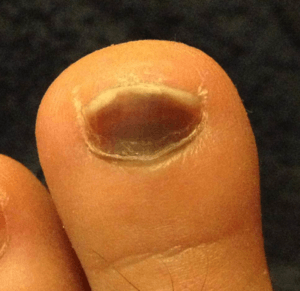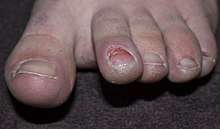Subungual hematoma
A subungual hematoma is a collection of blood (hematoma) underneath a toenail or fingernail (black toenail). It can be extremely painful for an injury of its size, although otherwise it is not a serious medical condition.
| Subungual hematoma | |
|---|---|
| Other names | Runner's toe, tennis toe, skier's toe |
 | |
| Subungual hematoma of a toe | |
| Specialty | Emergency medicine |
Causes

Runner's toe is a common condition seen in runners caused by downward pressure or horizontal separation of nail plate from the nail bed. This repetitive traumatic injury leads to bleeding and pooling of blood underneath the nail plate. Clinically, it is characterized by reddish-black discoloration of the toe nail. The nail plate may also become thicker and more brittle as a result of the injury (onychochauxis). The deformed nail plate will gradually grow out and be replaced by new, normal-appearing nail plate in several months time. Infrequently, the toe may become painful and require surgical drainage.
Runner's toe is often associated with malfitting shoes and insufficient space for the toes. Some susceptible runners may also have Morton's toe. In this variant of human foot anatomy, the second toe extends further out than the great toe. The key to prevention of runner's toe is to purchase properly fitted shoes.
The condition also results from a traumatic injury, such as slamming a finger in a door,[1] or from sports activities, such as climbing or hiking rugged terrain. A subungual hematoma that results from the repetitive thrusting of the longest toe into a shoe's toe box is called jogger's toe[2] or runner's toe.
The bleeding comes from the (vascular) nail bed underlying the (avascular) nail plate. A laceration of the nail bed causes bleeding into the constricted area underneath the hard nail plate.[3] Throbbing pain is common. The nail develops a black discoloration overlying the nail bed but under the nail plate.
Treatment
Subungual hematomas are treated by either releasing the pressure conservatively when tolerable by drilling a hole through the nail into the hematoma (trephining), or by removing the entire nail. Trephining is generally accomplished by using a heated instrument[4] to pass through the nail into the blood clot. Removal of the nail is typically done when the nail itself is disrupted, a large laceration requiring suturing is suspected, or a fracture of the tip of the finger occurs. Although general anesthesia is generally not required, a digital nerve block is recommended to be performed if the nail is to be removed.
Subungual hematomas typically heal without incident, though infection or disruption of the nail (onycholysis) may occur.
See also
References
- "Subungual Hematoma: Care Instructions". myhealth.alberta.ca.
- Mailler, E A; Adams, BB (2004). "The wear and tear of 26.2: dermatological injuries reported on marathon day". British Journal of Sports Medicine. 38 (4): 498–501. doi:10.1136/bjsm.2004.011874. PMC 1724877. PMID 15273194.
- Selbst SM, Attia M (2006). "Lacerations". Textbook Of Pediatric Emergency Medicine. Hagerstown, MD: Lippincott Williams & Wilkins. p. 1571. ISBN 978-0-7817-5074-5.
- "Primary Care Procedures: Trephination of Subungual Hematoma". consultantlive. UBM Medica, LLC. Retrieved 30 July 2016.
External links
| Classification | |
|---|---|
| External resources |